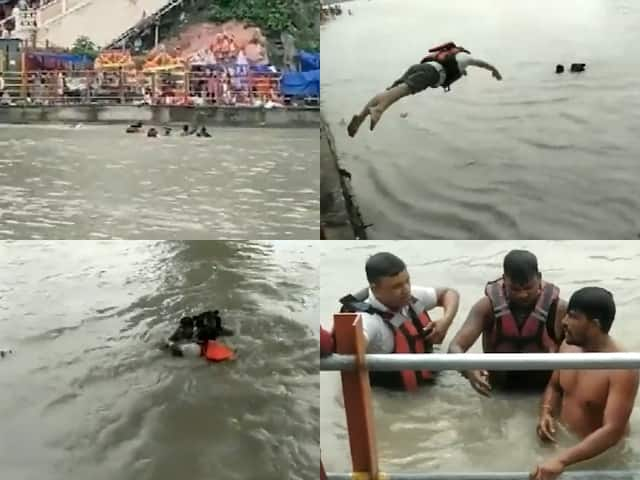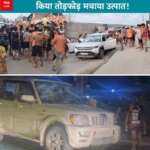Rising Crowd of Kanwar Pilgrims Raises Concerns Over River Safety: Incidents in Haridwar and Jabalpur Highlight the Risks
Haridwar/Jabalpur, July 2025 – The sacred month of Sawan marks a significant period for millions of Kanwar pilgrims across India, as they embark on their annual spiritual journey to collect holy water from the Ganges and other revered rivers. However, the growing influx of devotees, combined with the unpredictable monsoon-fed river currents, has once again brought river safety into sharp focus. Recent incidents in Haridwar and Jabalpur have underscored the urgent need for heightened awareness and caution among pilgrims and tourists alike.

The Kanwar Yatra: A Spiritual Journey
The Kanwar Yatra, one of the largest annual religious gatherings in India, sees devotees known as ‘Kanwariyas’ carry decorated pitchers of holy water, often walking hundreds of kilometers to offer it at Shiva temples. Haridwar, with its ghats lining the Ganges, becomes a focal point during this period, drawing pilgrims from across the country.
As Sawan commenced this year, the number of Kanwariyas in Haridwar has surged, with crowds swelling each day. Before beginning their journey, it is customary for pilgrims to bathe in the Ganga, seeking purification and blessings. However, this sacred ritual is not without its dangers.
The Perils of the Ganges: Recent Incidents
The Ganges, revered as a goddess in Hinduism, is a lifeline for millions but also poses significant risks, especially during the monsoon. Heavy rains in the Himalayan foothills cause the river’s water levels and currents to rise dramatically. Many pilgrims, unfamiliar with the river’s unpredictable nature, often underestimate its force.
Recently, three Kanwariyas were swept away by the powerful currents while bathing at one of Haridwar’s ghats. Thanks to the vigilance and swift action of the State Disaster Response Force (SDRF) and water police stationed at the site, all three were rescued in time. The incident, captured in dramatic visuals, has served as a stark reminder of the ever-present dangers associated with river bathing during the monsoon.
Local authorities, including the Haridwar district administration, have deployed SDRF teams, water police, and Provincial Armed Constabulary (PAC) personnel at key ghats to monitor the crowds and respond to emergencies. “Despite our best efforts, the river’s flow cannot be controlled,” said a senior official. “We urge all pilgrims to exercise extreme caution and not to underestimate the strength of the Ganga, especially during the monsoon.”
Official Appeals and Safety Measures
In response to the recent incidents, both local authorities and the National Disaster Response Force (NDRF) have issued urgent appeals to pilgrims. “Please do not risk your life by entering fast-flowing rivers to collect water,” reads an advisory. “Perform your rituals, but prioritize your safety.”
The administration has also increased signage at the ghats, warning of deep water and strong currents. Loudspeakers broadcast regular safety announcements, and volunteers guide pilgrims to safer bathing spots. Despite these efforts, the sheer volume of devotees makes crowd management a daunting challenge.
The Monsoon Effect: Rising River Levels Across India
The risks are not limited to Haridwar. Across northern and central India, the monsoon has led to rising river levels, swelling reservoirs, and increased incidents of flooding. In Jabalpur, Madhya Pradesh, authorities recently opened 17 gates of the Bargi Dam to manage the excess inflow from the Narmada River. The release of water has inundated several low-lying areas, with the famous Bhedaghat tourist spot now submerged under heavy rainfall and upstream discharge.
Tourists at Bhedaghat, known for its marble rocks and waterfalls, have also been seen venturing dangerously close to the swollen river, some even bathing in the swift currents. Authorities have repeatedly warned against such risky behavior, emphasizing that the river’s force can be deadly and that the water does not discriminate between pilgrims and tourists.
The Human Factor: Underestimating Nature
One of the recurring themes in these incidents is the tendency of people to underestimate the power of nature. Whether driven by faith, tradition, or a sense of adventure, many fail to recognize the risks posed by fast-moving water. The river’s surface may appear calm, but hidden currents and sudden changes in water level can catch even experienced swimmers off guard.
“We cannot control the river’s flow, only its level to some extent,” explained a local administrator in Haridwar. “The best protection is awareness and caution. Unfortunately, many pilgrims, in their devotion, ignore warnings and venture too far into the water.”
The Role of Rescue Teams
The presence of SDRF, NDRF, and local water police has undoubtedly saved countless lives. Their teams are trained to respond rapidly to emergencies, often risking their own safety to rescue those in distress. In Haridwar, the timely intervention of SDRF personnel was instrumental in saving the three Kanwariyas who were swept away.
However, officials caution that rescue teams can only do so much. “Our teams are vigilant, but with such large crowds, it’s impossible to prevent every incident,” said an SDRF officer. “We appeal to everyone to follow safety instructions and avoid unnecessary risks.”
Community Responsibility and the Way Forward
The recurring incidents highlight the need for a collective approach to safety. While authorities can provide infrastructure, deploy rescue teams, and issue advisories, the ultimate responsibility lies with individuals to heed warnings and act responsibly.
Religious leaders and community organizations have also joined the call for caution, urging devotees to respect both the sanctity and the dangers of the rivers. “Faith should not come at the cost of life,” said a prominent priest in Haridwar. “We must honor our traditions, but also protect ourselves and our loved ones.”
Conclusion: Balancing Faith and Safety
The Kanwar Yatra and similar pilgrimages are integral to India’s spiritual and cultural fabric. They bring together millions in an expression of devotion, unity, and tradition. Yet, as the recent events in Haridwar and Jabalpur demonstrate, these journeys are not without risk, especially during the volatile monsoon season.
As the number of pilgrims continues to rise, so too does the need for vigilance, preparedness, and respect for nature’s power. Authorities, rescue teams, and community leaders are doing their part, but the message is clear: safety must come first.
Whether you are a Kanwariya collecting holy water, a tourist enjoying the beauty of India’s rivers, or a local resident, remember that the river’s flow is indifferent to our intentions. Take precautions, follow official advice, and ensure that your spiritual journey does not turn into a tragedy.
For more updates on monsoon safety, river conditions, and pilgrimage advisories, stay tuned to local news and official channels.
News
Air India Flight AI171 Crash: 260 Dead, Investigations Underway, and the Wait for Answers
Air India Flight AI171 Crash: 260 Dead, Investigations Underway, and the Wait for Answers By Deependra Gandhi | July 2025…
Targeted in Mumbai: A Woman’s Ordeal Highlights Intimidation and Identity Politics
Targeted in Mumbai: A Woman’s Ordeal Highlights Intimidation and Identity Politics Introduction Mumbai, India’s bustling financial capital, is often celebrated…
Tragedy in Haryana: The Murder of Tennis Star Radhika Yadav and the Shadows of Patriarchy
Tragedy in Haryana: The Murder of Tennis Star Radhika Yadav and the Shadows of Patriarchy Introduction On July 10th, a…
Kedarnath: From Devastation to Rebirth – The Story of the 2013 Tragedy and Remarkable Recovery
Kedarnath: From Devastation to Rebirth – The Story of the 2013 Tragedy and Remarkable Recovery A Sacred Journey Interrupted June…
Shock and Mystery: The Tragic, Lonely Death of Actress Humaira
Shock and Mystery: The Tragic, Lonely Death of Actress Humaira Introduction: A Shocking Discovery The entertainment world was shaken to…
End of content
No more pages to load









